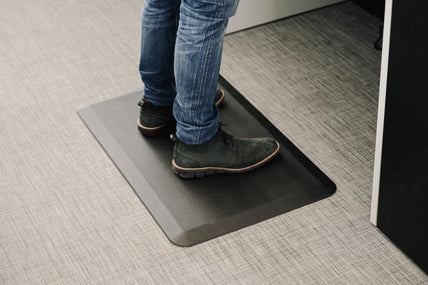Here Is Why You Should Use a Dual Screen Setup at Work
By Daniel Angelini on June 24, 2020Nearly every job today, whether based online or not, carries out some functions using computers. The standard setup is a single monitor, and this has worked for people since the first personal workstations were adopted for office use.
Today, however, an increasing amount of roles are starting to require more screens. From software engineers to designers, bankers to teachers, doctors, architects, and more, multiple-monitor setups are useful wherever a professional needs to work on a large amount of information at once.
For many people, nothing beats the immersive quality of having more than one screen at work. Though mobile devices are popular for browsing and gaming, full-sized screens are still better for hunkering down and doing deep work. Aside from their capacity for more data, it is also vital for some professions that monitors can be rearranged or repositioned. For example, doctors performing a crucial operation would benefit immensely from a terminal equipped with a multi-monitor arm.
Yet you don't have to be doing something as complex as a surgery to use a dual- or multiple-monitor system. Daily tasks at work can be made more efficient with an expanded setup. In a study published in The Journal of Life and Environmental Sciences, researchers found that participants who used a dual monitor desktop computer setup made fewer errors in their work compared to ones that used other configurations.
Furthermore, the researchers highlight the fact that their findings confirm results in dozens of other journal articles. They reiterate that multiple-monitor systems are more effective than single-monitor ones, and lead to more productivity, a better ability to spot errors, and is generally more suitable for ‘information-rich’ activities.
Workers find multi-screen configurations more comfortable, and these help them become more productive. It is easier to track tasks on multiple screens, based on the results of a landmark study by researchers at the University of Utah. Moving from a single- to a dual-monitor setup, the participants were 44 percent more productive on text-based tasks, and 29 percent more for work on spreadsheets.
Once employees start working with multiple monitors, they often show a preference for staying with that setup. shows that people’s productivity can increase up to 50 percent. Another study by Wichita State University showed that an overwhelming majority of the participants preferred the two-monitor configuration after trying it for the study.
The preference for more monitors is natural, since this lets users display more content in larger resolutions. It also allows them to use more applications, switch between these quickly, and view different programs without having to minimize their screen. Two monitors also allow workers to look at documents side by side. This allows for easier copying and pasting, as well as fact-checking and proofreading.
Thus, more screens let workers exercise a greater amount of control over their workflow, and gives them the ability to choose how to display their programs and applications. It is well-established that employee productivity increases with their levels of satisfaction, and a setup like this has a direct impact on how engaged and satisfied they will be with their work.
What You Need for a Dual Monitor Setup
It is important to prepare a workstation to accommodate a dual monitor system; ill-advised modifications might turn out to hinder productivity. For an ergonomic dual screen setup, use furniture or fixtures that enable “functional focal adjustment.” This will let the user situate their monitor at different levels or configurations while giving the option for a default setting.
People use multiple-monitor systems in different ways. The extended hours workers spend in front of screens also affect how they make themselves more comfortable as they work. There are workers who prefer a ‘take-It-In’ approach, where the user reclines on a chair and “takes in” the data from the different screens all at once.
Some people fall into trance-like states, where their workflow takes over and they tend to ignore things like posture and physiological needs. While this is great for short-term productivity, studies have shown that this is damaging to people’s health in the long run.
There are people who use a blended approach to their work, and perform tasks on multiple devices. They might use a desktop, but have a smaller display surface nearby like a smartphone or a tablet.
Multiple-monitor systems need an adjustable multi-monitor arm, an adjustable standing desk, and comfortable seats. An adjustable arm lets a user customize the screen’s tilt and height; combined with height-adjustable surfaces, this allows them to work uninterrupted while they take a stand-up break.
When purchasing items for a workstation, be sure to find furniture and equipment that work with the body’s natural structure. This is the goal of ergonomic design; it reduces the impact of prolonged sitting or standing. Each person has different needs; height, limb length, strength and stamina, and many other things influence the types of desks and chairs that reduce strain.
For instance, someone who is petite would not enjoy using a chair that has long legs; conversely, a tall person might feel cramped in a short chair. Ergonomic furniture is adjustable. It can be positioned in relation to the user’s preferences. This is especially crucial for dual-monitor systems; when this is not set up properly, it can cause neck and eye strain.
People who work with two monitors must identify the percentage of their work that is done on either screen, the type of work they do, and their dominant eye or hand. These all contribute to how ergonomic or impractical a dual-screen workstation becomes.
A person’s dominant hand is the one they use for writing. The dominant eye is the one that provides information to the brain. Generally speaking, a person’s handedness translates to eye dominance; if you’re left-handed, you’re likely to have a dominant left eye. Thus, your monitor and keyboard should align to favor this side of your face and body.
Furthermore, the distance of the monitors should allow for a neutral neck position. Users should not need to tilt their head back or look down into a screen. If one monitor is used more frequently, the screens should be placed at an arc, with the primary monitor slightly forward. To avoid neck strain, check if the top line of the monitor can be viewed without moving the head.
If the monitors are used equally, they should be positioned as if they form one long monitor. This helps the user have a wider field of vision, and prevents neck strain caused by moving the head from one screen to the other. Using a dual monitor arm will make setting this up easy.
Alternatively, you may prefer angling the two monitors slightly to meet in the middle—this is easy if the monitors are mounted on an adjustable arm. Make sure that your view is not distorted, and place your keyboard and mouse in front of you. If your other equipment is too far, it will make your shoulders or back tense. Opt for keyboard trays and mouse pads that are specifically designed for user comfort.
Conclusion
A dual-monitor setup works well for people in ‘information-rich’ roles, or ones that require them to view a lot of data all at once. It makes people productive and lets them have more control over how they fulfill their duties at work. However, it is also important to balance productivity with ensuring worker health; workstations should be configured with an eye toward ergonomics.
Let our team at Movi Workspace help you create an ergonomic workstation. Our sit-down, stand-up desks and multi-monitor desk mounts have satisfied many Australians! Get in touch with us today to learn more!










